June 2024
In this edition:
- Partner Q & A: How BC Hydro helps support the Aboriginal Housing Management Association
- BC Land Summit zeroes in on B.C.'s new multi-unit housing bill
- Richmond builds flexibility into EV Ready Plan
- Optional rate provides discounts for overnight energy use
- BC Community Climate Dashboard goes live
- News about BC Hydro and from around our community
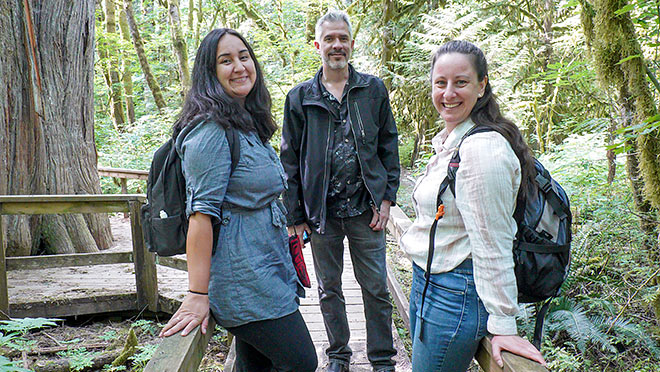
Partner Q & A: How BC Hydro helps support the Aboriginal Housing Management Association
As Canada's first for Indigenous by Indigenous housing authority, the Aboriginal Housing Management Association (AHMA) supports Indigenous housing and service providers in B.C. to provide culturally-safe, secure, and affordable off-reserve housing.
Back in 2020, AHMA's Patrick Caraher reached out to BC Hydro's Seth Oldham and Amy Seabrooke. Since then, we've helped fund several staff positions at AHMA aimed at ensuring our incentive programs become more effective and available to those living off reserve through urban Indigenous housing providers.
We sat down recently with Sara Fralin, the AHMA's engagement and technical support manager, to chat about how the organization works with BC Hydro and others to help support about 10,000 Indigenous families in B.C.
Note that this conversation has been edited for brevity and clarity.
Plugged In: What do you think is the most misunderstood aspect of Indigenous housing in B.C.?
Sara Fralin: I think that in general, people are unaware that off-reserve, urban Indigenous people in British Columbia make up about 75% of the total Indigenous population in the province. So it's huge. And we are the only Indigenous-led organization that supports Indigenous non-profits operating in that sector.
PI: How is the partnership with BC Hydro, and specifically the four co-funded positions in your organization, supporting your work now? Are the roles specifically around energy efficiency, electrification, or both?
SF: Their roles are quite diverse. We have two housing condition advisors who perform on-site building condition assessments. They gather data around the condition of buildings, because we can't move forward with any sort of energy planning until we know, for example, the age and condition of existing lighting. We also fund an energy project coordinator, who does a lot of our lead partnerships and stewardship work. And we have an energy project advisor who works directly with our project managers and supports integrating energy retrofits into existing project scopes. They not only provide expertise and advice, but also do all the paperwork to access the funding incentive programs for energy retrofits and upgrades."
PI: What would you say are your two biggest challenges in bringing energy efficiency and electrification to Indigenous housing?
SF: The number one challenge is that there's not enough funding for basic health and safety. So energy is not the top priority. The second big one is the complexity around accessing funding for studies and projects. We're in a position where we need to stack multiple sources of funding at various stages of the capital planning process in order to see a project move forward. And we don't have the staff capacity to do that.
PI: Your organization has fully embraced the opportunity to add air conditioning to Indigenous homes through BC Hydro's free portable air conditioning offer. Tell us how that happened.
SF: That offer was amazing because there wasn't a complicated application to deal with. It was like "you find out who needs the AC units and send us the bill".
PI: How important is access to air conditioning for Indigenous housing?
SF: Indigenous peoples' comorbidities are a legacy of colonialism and have a direct impact on health and well-being. Indigenous people tend to be more at risk to the impacts of extreme heat, specifically around health and safety. We just published a report [PDF] about that, and there are a number of calls to action in the report around how service providers can better work together to reduce barriers and improve access to support services. We know that AC units can be life saving for individuals, and that's been a huge driver in identifying the most vulnerable members of our community.
PI: You have a Masters degree in sustainability studies and you worked extensively in sustainability in your lead-up to joining the AHMA. How do you make sustainability more of a constant in the delivery of Indigenous housing?
SF: Sustainability is a complex term that includes social, environmental and economic aspects. The social housing sector is not an economically sustainable sector. It's a sector based on government subsidies and support. On the social side, we advocate for a culturally safe trauma-informed approach to integrating reconciliation into everything we do, including housing design. We're still working with partners to develop Indigenous housing design guidelines, to train folks on cultural safety, to ensure that there is a large Indigenous workforce that's able to work in the sector. And on the environmental side, it's super complicated. Energy conservation, for example, is a big push, not necessarily because we have a mission to mitigate climate change, but because folks can't afford to pay their energy bills.
PI: If you had one wish for Indigenous housing, what would that be?
SF: Just a big pot of money for us to work with ... Some of our housing and service providers can't even cover their basic bills right now due to shoestring budgets, and they are on the frontlines of preventing homelessness across B.C. for those most in need of support ... Or a change so that we don't have to apply for funding for projects.
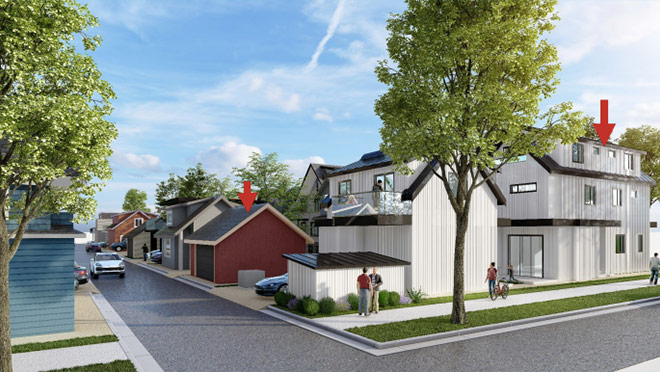
Switching on sustainable housing – What does it take to electrify our densifying communities?
It came as absolutely no surprise that a fresh piece of B.C. legislation around housing densification was in the spotlight at May's 2024 BC Land Summit in Nanaimo. In November 2023, the Province adopted Bill 44 which requires local governments to update their bylaws to allow multiplexes on most single-family lots. This will make it easier for builders to create small-scale, multi-unit homes such as multiplexes and coach houses in existing neighbourhoods.
The BC Land Summit is a collaborative once-every-five-years event for B.C. land use practitioners. BC Hydro staff joined planners, architects, and sustainability managers in an interactive panel presentation to discuss how an increase in multiplex developments will change servicing requirements and capital investment for both BC Hydro and municipal services.
In a lively panel, Rebecca Newlove, manager of sustainability for the District of Saanich, urged attendees to work closely with BC Hydro. "We need new housing for our communities," said Newlove. "And we need electrification of buildings and transportation to meet our climate action targets. So local governments need to be working in lock step with BC Hydro."
BC Hydro's Robyn Wark, manager of BC Hydro's market transformation group, then provided a visual deep dive into BC Hydro's electricity system and our $36 billion infrastructure plan. She laid out why the organization needs to work closely with city planners, architects, and landscape architects to roll out this infrastructure and efficiently connect customers.
"We are in the midst of an energy transition" Wark noted. "British Columbians are switching from fossil fuels to cleaner, renewable sources of power. Today, electrification is the most available pathway for our customers to decarbonize, which has resulted in an unprecedented level of anticipated interest and demand in our electricity system. Close partnerships with local governments will allow us to roll out our capital plan and efficiently connect customers."
Wark then introduced Chris Higgins, a City of Vancouver planner who has been working one day a week out of BC Hydro offices to streamline processes for builders applying for multiplex permits. The City of Vancouver was first out of the gate allowing multiplexes on single family lots.
"I've loved working at BC Hydro so that we can both cut red tape together," said Higgins. "Over the last six months, the City has received over 150 applications for multiplexes, and has required that builders contact BC Hydro immediately so that the processing can happen simultaneously. So far BC Hydro has completed all designs ahead of the City, ensuring that there are no delays for builders.
"The City has realized that BC Hydro can make the quickest and most cost-effective decisions around electrical infrastructure by working directly with the builder. So we have removed all our custom requirements for small-scale developments such as undergrounding requirements that previously had slowed things down."
The panel wrapped up with Maciek Dobrowolski, BC Hydro's design manager in Nanaimo, outlining how BC Hydro has been investing in new positions and processes to help multiplex builders get quicker electrical connections. He then offered suggestions of things that local governments can do to help too, including instructing builders to contact BC Hydro at the same time as the City, allowing builders to use existing overhead connections if needed, and helping them locate any electrical transformers on their property or on City property.
"We will be continuing to work closely with our municipal partners," noted Dobrowolski. "We are both working together to reduce red tape and helping builders connect quickly and easily to the BC Hydro grid."
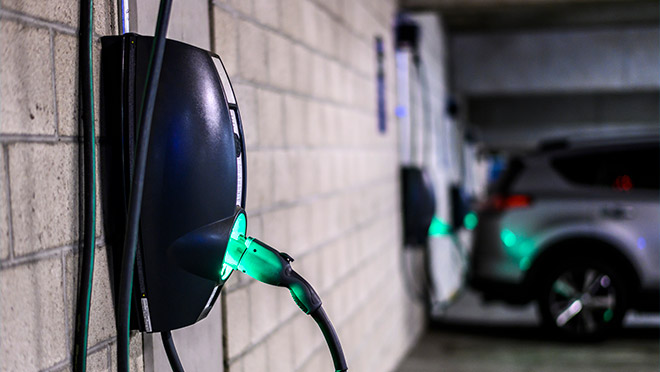
Richmond builds flexibility into EV charging requirements for new commercial and workplace buildings
The City of Richmond has added a new compliance pathway for developers to meet its EV-ready buildings requirement for non-residential new buildings – such as offices and shopping malls. This alternate compliance pathway is less prescriptive and more responsive to the specific needs of these new buildings. Rather than prescribing exactly how many Level 2 and DCFC chargers must be delivered, they're allowing an alternative in which the developer decides what will work best for the particular building.
"Different commercial and industrial facilities have different requirements," says Arzan Balsara, senior climate action specialist at the City of Richmond. "They might be needing to provide chargers to their employees, to their customers, or to people who live in the area. It could be all Level 2, or a split between Level 2 and DCFC fast charging."
Richmond's basic requirement for employee, customer, residential visitor and unclassified parking spaces is that 35% of parking spaces have EV charging infrastructure installed and capable of supporting a charging capacity of at least 1.66 kW, and that another 10% of spaces (with a minimum of one space) have EV charging infrastructure installed capable of supporting faster charging of at least 6.66 kW. This is equivalent to requirements already adopted by the Cities of Vancouver and North Vancouver.
The City of Richmond's alternate compliance pathway is designed for flexibility. It allows any combination of Level 2 and DC fast charging infrastructure, provided that the total installed capacity of required charging infrastructure exceeds 1.25 kW multiplied by the total number of employee, customer, residential visitor and unclassified parking spaces.
Balsara arrived at his City of Richmond job last year and is intent on carrying on the great work of former sustainability manager Brendan McEwen, whose position was co-funded by BC Hydro and the City, and has since moved on to the clean energy consultancy Dunsky. Balsara credits McEwen and his team for having the foresight to anticipate B.C.'s continent-leading growth in EV adoption.
"The partnership between BC Hydro and the City has been groundbreaking" McEwen notes. "Over the last five years, BC Hydro has been co-funding the City's research and policy development and turning it into best practice guides to share with other local governments.
"They also run a peer network to share these practices, and co-fund community energy manager positions in municipalities so that requirements line up between all local governments. It has made B.C. a leader in EV-ready requirements for new buildings – an approach that has been taken up across North America."
While most EV charging happens at home, public charging is also an important part of the mix. The City of Richmond has discovered that as soon as public charging rolls out, it tends to get busy.
BC Hydro currently operates 183 public charging ports in B.C., and is now looking to add 3,000 more to its network by 2030. Combined with City policies this should make it easier for people in Richmond and throughout B.C. to charge their cars at home, at work and on the go.
Optional rate provides discounts for overnight energy use
We'd like your help in spreading the word to residential customers about who stands to gain the most from our residential tiered rate with time-of-day pricing.
On this new, optional rate plan, the price of electricity varies based on how much you use, and the time of the day when you use it. It's a rate that suits those in the best position to shift some of their energy usage away from on-peak hours.
Here's how it works:
- Two-tier pricing still applies. All usage up to a certain threshold in each billing period costs a lower, Tier 1 price, and all usage above that threshold costs a higher, Tier 2 price.
- There's an overnight discount of -5 cents per kilowatt-hour (kWh) for energy use between 11 p.m. and 7 a.m.
- There's an on-peak surcharge of +5 cents per kWh for electricity used from 4 to 9 p.m.
- There's no discount or surcharge for usage between 7 a.m. and 4 p.m., and 9 to 11 p.m., which are called off-peak hours.
A senior product manager with BC Hydro, Sarb Verma says this new optional rate is part of an evolution in offering more rate options for customers. What has long been a one-size-fits-all approach to residential rates is changing to meet the evolving needs of households.
Many Alliance members are in the unique position of dealing closely with residential customers who are having Level 2 EV chargers or solar panels installed.
"This is not an energy efficiency rate like the standard residential tiered rate that's been a signal to consume less," she says. "Customers are likely to consume pretty much the exact same amount under this rate, but it's aimed to just shift the load away from peak periods."
In marketing time-of-day pricing, we're using four conservative estimates for potential savings from opting in and shifting customer home energy behaviours:
- Shifting charging an EV from after 5 p.m. to after 11 p.m. could save up to $125 a year.
- Shifting once-a-day dishwashing from 7 p.m. to after 11 p.m. could save up to $25 a year.
- Shifting twice weekly laundry from 7 p.m. to after 9 p.m. could save up to $25 a year.
- If you have a 7 kW solar installation, you're already limiting usage from the grid during on-peak hours and could save up to $52 a year on the optional rate.
All of the above are estimates and each customer may see different bill impacts.
We have an online calculator and self-serve tools to help
We've put together a suite of resources to help customers decide whether the optional rate will work for them, and then to manage their rate plan and usage. Customers always have the choice change their rate plan back if the optional rate isn't working for them.
- Online rate estimator: Customers can log in and compare annual, estimated electricity costs on each rate plan based on their actual 12-month historical consumption data, and test how shifts in when they use electricity might change their costs.
- Tips to save: Customers can learn tips to shift energy use at home to save, and how to read time-of-day graphs in MyHydro.
- Online self-serve tools: Customers can change their rate online or contact our call centre and speak with a representative.
- Sign-up on move-in: We've integrated a seamless sign-up to the time-of-day rate option in our online moving request service.
- Consumption graph downloads: Customers can download historical hourly data to run their own analysis.
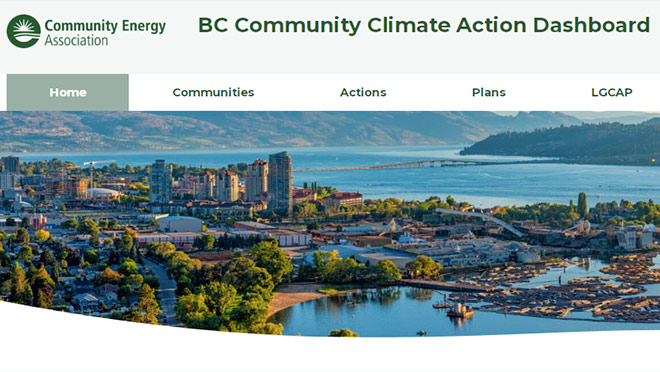
The BC Community Climate Action Dashboard goes live
With local governments across B.C rapidly adopting climate and energy regulations and policies, it's a challenge to keep track of who's doing what. That's where the BC Community Climate Action Dashboard, created by the Community Energy Association (CEA) with funding from BC Hydro and the Government of B.C., comes in.
Created with the needs of local government staff and elected officials in mind, the dashboard is a web-based tool that's designed to track climate action progress for all local governments in B.C.
"There are 189 local governments, and their work on climate action is complex," says Rebecca Cuttler, the CEA's local government climate network coordinator.
The first version of the Dashboard includes:
- Community-by-community Energy Step Code and Zero Carbon Step Code listings
- Other local government climate regulations, such as EV-ready building bylaws
- Climate Action Plans
- LGCAP reports
Robyn Webb is BC Hydro's program manager for local government conservation and climate action. A long-time worker in local government before joining BC Hydro, Webb says the tool would have been a go-to option during her last job with the City of Victoria.
"The last thing I worked on with Victoria was passing an EV Ready bylaw," she says. "It was an expectation of council that you do a jurisdictional review of who else had done this, how they had done it, and when it had been implemented. I really had to muddle through a lot of information and make a lot of calls to other local governments to find what I needed. With the Dashboard, it should be much easier to prepare."
The Dashboard will help local governments develop best practices, foster peer learning and leverage climate action by easily sharing what they and other communities are doing. And it's publicly available for all to explore, community by community, and with filters that allow you to zero in on everything from energy efficiency retrofit programs to EV charging policies, and to sort by population, climate zone, and region.
Explore the BC Community Climate Action Dashboard today, and if you have questions about it, or you would like to schedule a guided walk-through of the tool, email the Community Energy Association.
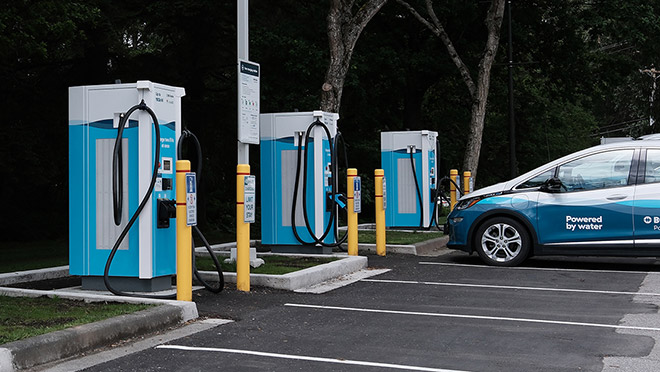
News about BC Hydro and from around our community
- BC Hydro has launched a call for power to ensure that people and businesses will have the clean, affordable electricity needed to power B.C.'s growing economy and create jobs throughout the province.
- The Building and Safety Standards Branch (BSSB) has released the updated Local Government Best Practice Guide [PDF], which provides guidance to local governments on what to consider when consulting and adopting the Zero Carbon Step Code and the higher Steps of the Energy Step Code.
- The Canadian Standards Association recently released the second edition of its SPE-17:23 HVAC Guide for Part 9 Homes. It's designed to help builders, architects/designers, and building officials adopt approaches that improve HVAC performance for Part 9 homes.
- The BCUC has approved new energy based EV charging rates, for public electric vehicle charging.
- BC Hydro has worked with the City of Surrey to open the first of four public EV charging pods in the community.